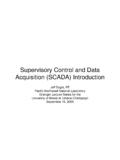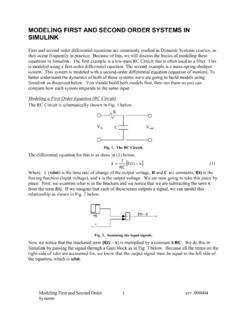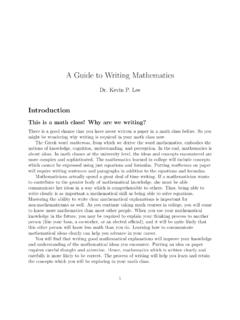Transcription of The Basic Soldering Guide - science.smith.edu
1 The Basic Soldering Guide (for text in this document) basics for wire (Good intro) : The Happy Soldering Iron: basics: Watt/temp comparison tip sizes: types of solder: maintenance: Good overview with some odd bits: Desoldering overview: 2nd good overview: Hot air pencil/gun: Desoldering gun (short): Crazy Guy from Make Electronics: Not Soldering !! Bread board: This written Guide will help beginners and novices to obtain effective results when Soldering electronic components. If you have little or no experience of using a Soldering iron, then EPE (Everyday Practical Electronics magazine) recommends that you practice your Soldering technique on some fresh surplus components and clean stripboard (protoboard), before experimenting with a proper constructional project.
2 This will help you to avoid the risk of disappointment when you start to assemble your first prototypes. If you've never soldered before, then read on! Soldering irons The most fundamental skill needed to assemble any electronic project is that of Soldering . It takes some practice to make the perfect joint, but, like riding a bicycle, once learned is never forgotten! The idea is simple: to join electrical parts together to form an electrical connection, using a molten mixture of lead and tin (solder*) with a Soldering iron. A large range of Soldering irons is available - which one is suitable for you depends on your budget and how serious your interest in electronics is. [*Note: the use of lead in solder is now increasingly prohibited in many countries.]
3 "Lead free" solder is now statutory instead.] Electronics catalogues often include a selection of well-known brands of Soldering iron. Excellent British-made ones include the universally popular Antex, Adcola and Litesold makes. Other popular brands include those made by Weller and Ungar. A very Basic mains electric Soldering iron can cost from under 5 (US$ 8), but expect a reasonable model to be approximately 10- 12 (US$ 16 - 20) - though it's possible to spend into three figures on a Soldering iron "station" if you're really serious! Check some suppliers' catalogues for some typical types. Certain factors you need to bear in mind include:- Voltage: most irons run from the mains at 240V.
4 However, low voltage types ( 12V or 24V) generally form part of a " Soldering station" and are designed to be used with a special controller made by the same manufacturer. Wattage: Typically, they may have a power rating of between 15-25 watts or so, which is fine for most work. A higher wattage does not mean that the iron runs hotter - it simply means that there is more power in reserve for coping with larger joints. This also depends partly on the design of the "bit" (the tip of the iron). Consider a higher wattage iron simply as being more "unstoppable" when it comes to heavier-duty work, because it won't cool down so quickly. Temperature Control: the simplest and cheapest types don't have any form of temperature regulation.
5 Simply plug them in and switch them on! Thermal regulation is "designed in" (by physics, not electronics!): they may be described as "thermally balanced" so that they have some degree of temperature "matching" but their output will otherwise not be controlled. Unregulated irons form an ideal general purpose iron for most users, and they generally cope well with printed circuit board Soldering and general interwiring. Most of these "miniature" types of iron will be of little use when attempting to solder large joints ( very large terminals or very thick wires) because the component being soldered will "sink" heat away from the tip of the iron, cooling it down too much. (This is where a higher wattage comes in useful.)
6 A proper temperature-controlled iron will be quite a lot more expensive - retailing at say 40 (US$ 60) or more - and will have some form of built-in thermostatic control, to ensure that the temperature of the bit (the tip of the iron) is maintained at a fixed level (within limits). This is desirable especially during more frequent use, since it helps to ensure that the temperature does not "overshoot" in between times, and also guarantees that the output will be relatively stable. Some irons have a bimetallic strip thermostat built into the handle which gives an audible "click" in use: other types use all-electronic controllers, and some may be adjustable using a screwdriver. Yet more expensive still, Soldering stations cost from 70 (US$ 115) upwards (the iron may be sold separately, so you can pick the type you prefer), and consist of a complete bench-top control unit into which a special low-voltage Soldering iron is plugged.
7 Some versions might have a built-in digital temperature readout, and will have a control knob to enable you to vary the setting. The temperature could be boosted for Soldering larger joints, for example, or for using higher melting-point solders ( silver solder). These are designed for the most discerning users, or for continuous production line/ professional use. The best stations have irons which are well balanced, with comfort-grip handles which remain cool all day. A thermocouple will be built into the tip or shaft, which monitors temperature. Anti-static protection: if you're interested in Soldering a lot of static-sensitive parts ( CMOS chips or MOSFET transistors), more advanced and expensive Soldering iron stations use static-dissipative materials in their construction to ensure that static does not build up on the iron itself.
8 You may see these listed as "ESD safe" (electrostatic discharge proof). The cheapest irons won't necessarily be ESD-safe but never the less will still probably perform perfectly well in most hobby or educational applications, if you take the usual anti-static precautions when handling the components. The tip would need to be well earthed (grounded) in these circumstances. Bits: it's useful to have a small selection of manufacturer's bits ( Soldering iron tips) available with different diameters or shapes, which can be changed depending on the type of work in hand. You'll probably find that you become accustomed to, and work best with, a particular shape of tip. Often, tips are iron-coated to preserve their life, or they may be bright-plated instead.
9 Copper tips are seldom seen these days. Spare parts: it's nice to know that spare parts may be available, so if the element blows, you don't need to replace the entire iron. This is especially so with expensive irons. Check through some of the larger mail-order catalogues. A solder gun is a pistol-shaped iron, typically running at 100W or more, and is completely unsuitable for Soldering modern electronic components: they're too hot, heavy and unwieldy for micro-electronics use. Plumbing, ! Soldering irons are best used along with a heat-resistant bench-type holder, so that the hot iron can be safely parked in between use. Soldering stations already have this feature, otherwise a separate Soldering iron stand is essential, preferably one with a holder for tip-cleaning sponges.
10 Now let's look at how to use Soldering irons properly, and how to put things right when a joint goes wrong. The Basic Soldering Guide Photo Gallery Soldering is a delicate manual skill which only comes with practice. Remember that your ability to solder effectively will determine directly how well the prototype or product functions during its lifespan. Poor Soldering can be an expensive business - causing product failure and downtime, engineer's maintenance time and customer dissatisfaction. At hobbyist level, bad Soldering technique can be a cause of major disappointment which damages your confidence. It needn't be like that: Soldering is really easy to learn, and like learning to ride a bike, once mastered is never forgotten!















